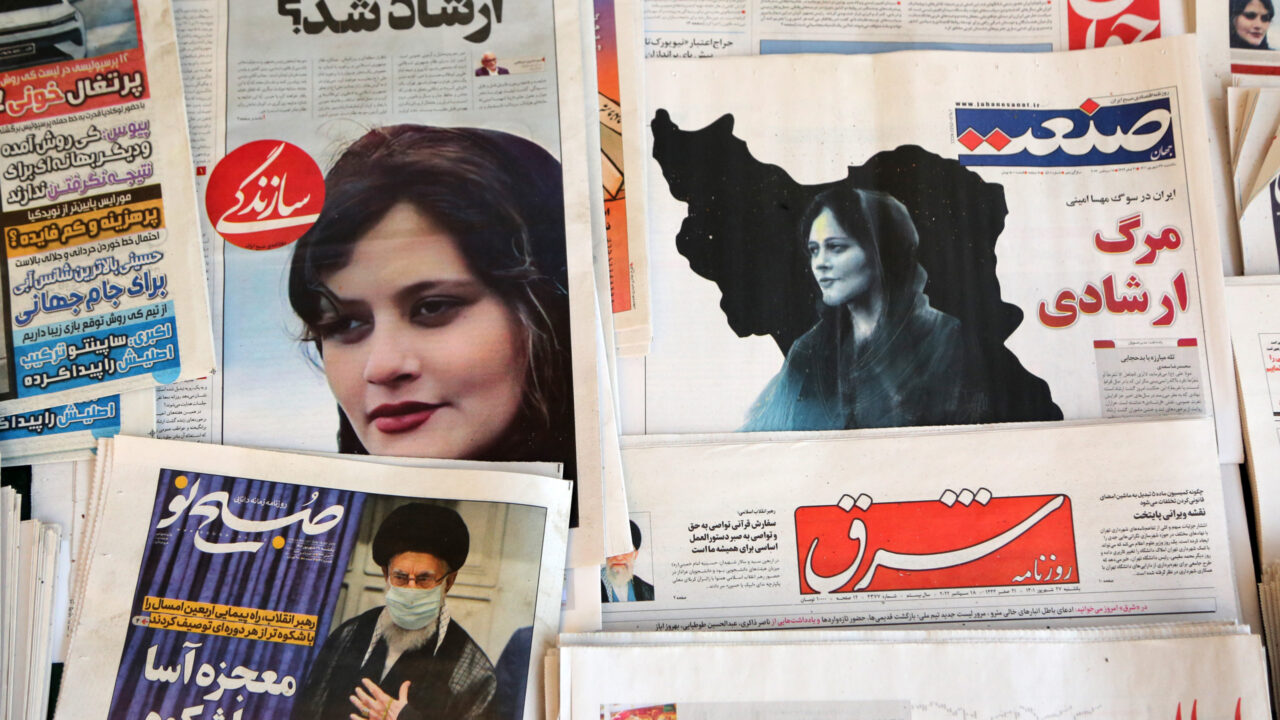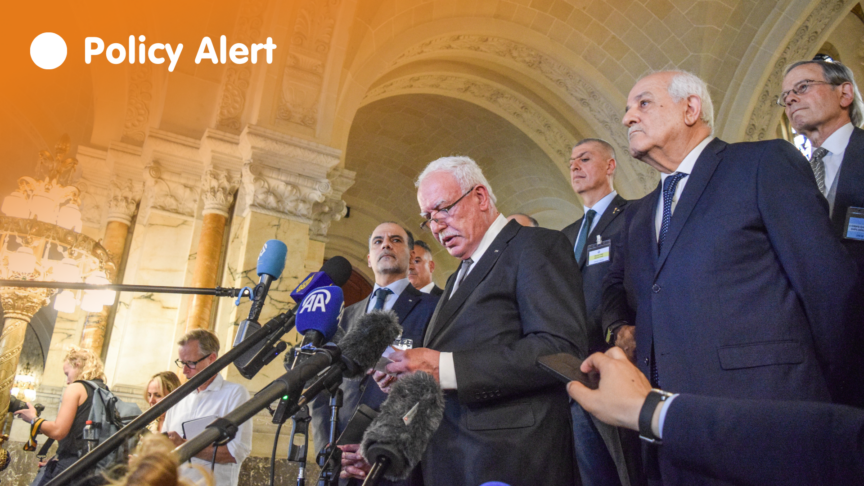Generation no: The Iranian uprising and how the West should respond
Young people in Iran have led mass protests after the death of a woman in police custody. The West should stand in solidarity with the protesters while keeping the diplomatic route open to constrain Iran’s nuclear programme
Widespread protests in Iran are about to enter their third week. The demonstrations erupted following the death of a young woman, Mahsa Amini, while in police custody for not covering her body ‘adequately’. This turmoil in Iran comes at a sensitive time for its relations with the West over stalled nuclear talks. As fears intensify over the Iranian government’s increasing use of violence against protesters, Western capitals are under pressure from groups that have long opposed diplomacy with Iran to scrap nuclear negotiations. Europe and the United States should not bow to these pressures. A diplomatic route to the restoration of the nuclear deal, rather than bombs or more sanctions, remains the best outcome – both for the West and for the Iranian people.
Since its inception, the Islamic Republic of Iran has faced countless protests in response to economic, social, and political grievances – such as the widespread demonstrations in both 2017 and 2019. In the past year alone, teachers and labourers have gone on strike over wages, while others have taken to the streets over access to water.
The events of recent weeks, however, are striking for the large numbers of young, ‘Generation Z’ participants – especially women – who have taken to the streets to demand accountability for Amini’s death, the repeal of hijab laws, and the abolition of Iran’s so-called morality police. Young women are removing their mandatory headscarves and setting them alight, cutting their hair as a symbol of a broader rally against a ruling system that is failing them. They have mobilised men and women across different generations and socioeconomic backgrounds to join them; while politicians, civil rights activists, tech companies, sports figures, and celebrities – both inside and outside Iran – are vocally supporting the cause. Indeed, the protesters’ demands quickly grew more ambitious, with chants of “death to the dictator” ringing out in various cities – a clear reference to the country’s supreme leader and the downfall of the Islamic Republic.
The Iranian authorities’ response has been predictably authoritarian: to date, the official death toll stands at 41 (with some estimates placing it at more than 80); there have been repeated internet blackouts; and the UN has warned of the mass arrests of activists, lawyers, and journalists – some of whom have supported engagement with the West and the reinstatement of the nuclear deal.
Compared to the brutal crackdown during the 2019 protests, however, it is clear that the authorities are not currently unleashing the full force of Iran’s security apparatus on the protesters. One reason could be that, unlike in 2019 under the relatively moderate government of Hassan Rouhani, hardline factions now control all major state institutions. As such, they bear full responsibility for events on the streets. It is also possible that the hardline factions in charge do not yet view Generation Z as a major threat – and are instead using this opportunity to arrest political figures and activists they fear could mobilise a real risk to their rule. But should the authorities’ assessment change, they will likely act with even greater force than they did three years ago to reinstate control.
So, although the frequency of nationwide protests since 2017 presents a major legitimacy challenge, the Islamic Republic does not appear to be on the verge of collapse. The grip of hardliners over key mechanisms of the state remains firm. The space for moderate political positions has shrunk as a result of the arrests and pressures from state authorities. And many Iranians have lost faith in figures associated with the moderate camp due to their inability to deliver reforms. Indicators of state collapse would include major visible splits within Iran’s security apparatus, and so far Iran’s conventional army has stated that it will act in line with the Revolutionary Guard Corps in response to the protests. It would also include mass labour strikes across the country, which are lacking today.
However, by arresting activists and moderate voices, Iran’s authorities are narrowing the scope for internal compromise and reconciliation. Therefore, Iranian society will likely become more polarised and the country will become more susceptible to regular uprisings. This makes it even more important to ensure Iran’s nuclear programme is contained through an agreement, rather than allowing the country to become another North Korea whose nuclear bombs and isolation provide cover for repression at home.
So far, European countries, the European Union, and the US have issued statements of support for Iran’s protesters, calling for accountability over the death of Amini and those killed in the protests. Germany summoned Iran’s ambassador. The US has sanctioned Iran’s morality police and prominent figures in the security forces – and the EU can follow suit at the upcoming Foreign Affairs Council. To reduce the impact of Iran’s internet blackouts, the US has eased its sanctions to allow greater provision of technology services to those inside Iran (something which human rights organisations had advocated for many years). In the days ahead, Europe and the US should more heavily press and incentivise technology companies to provide free access to those in Iran to enable a better flow of information among Iranian protesters.
Beyond this, Iran hawks are piling pressure on Western governments to punish Iran’s leadership by walking away from negotiations aimed at restoring the nuclear deal. But this approach – as the last 43 years have shown – will only reward and strengthen the most hardline camps in Iran that have thrived under isolation and sanctions.
For European capitals, Iran’s nuclear advancement still poses a key strategic risk that needs addressing.
During the Trump era, for example, a US policy of “maximum pressure” placed Iran under the most severe sanctions ever imposed, bringing the two countries close to war. An increasingly securitised atmosphere in Iran helped provide the breeding ground for hardline factions to consolidate their power, at a time when a transition may soon take place for the role of supreme leader. The Islamic Republic is unlikely to collapse if the West walks away from negotiations on the nuclear deal and returns to a maximum pressure campaign. Quite the contrary: abandoning diplomacy would only benefit the country’s hardline elites. They would pin the blame for the country’s economic troubles on the West, while using their isolation to weaken Iranian civil society – as well as further impoverishing the Iranian people and rendering them more internationally disconnected.
European governments should continue to publicly expose and hold Iran accountable for meeting its domestic and international obligations towards its own citizens. At the same time, they should continue to advance diplomacy aimed at restricting Iran’s nuclear programme. For European capitals, Iran’s booming nuclear activities still poses the key strategic risk that needs addressing. Indeed, the West rarely makes arms control deals with regimes that are allies: they strike these deals with those they perceive as a threat and which advocate hugely different values.
The reality is that nuclear negotiations may anyhow be on the verge of collapse. But if Europe and the US demonstrate they have exhausted all political paths to offer Iran sanctions relief in return for nuclear restrictions, this would place even greater responsibility – and pressure – on the shoulders of Iran’s leadership. If they choose not to take the political path, it falls on them to explain to their youth, why they have forgone the opportunities afforded by diplomacy. In such a scenario, it may well turn out that Generation Z – which increasingly perceives it has nothing to lose – poses the biggest threat to Iran’s leadership after all.
The European Council on Foreign Relations does not take collective positions. ECFR publications only represent the views of their individual authors.



